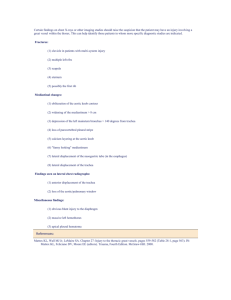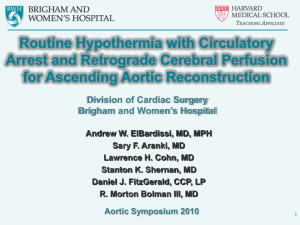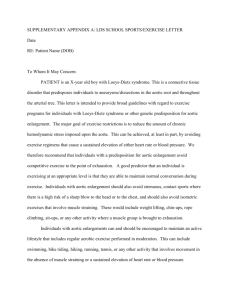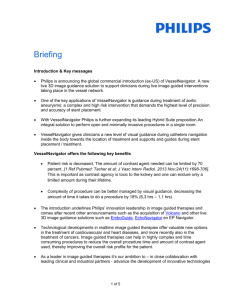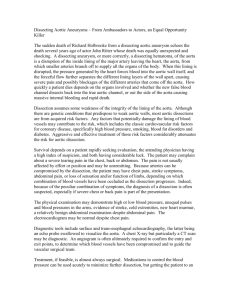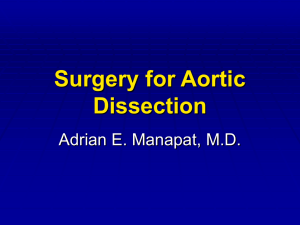When To Repair An Ascending Aortic Aneurysm
advertisement
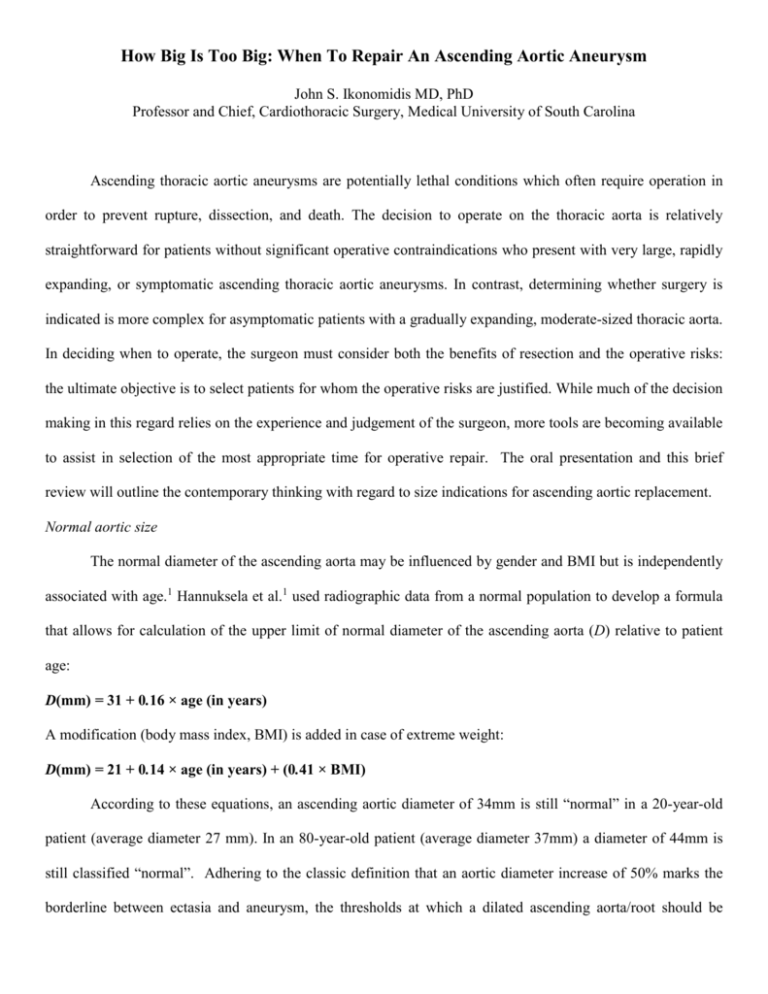
How Big Is Too Big: When To Repair An Ascending Aortic Aneurysm John S. Ikonomidis MD, PhD Professor and Chief, Cardiothoracic Surgery, Medical University of South Carolina Ascending thoracic aortic aneurysms are potentially lethal conditions which often require operation in order to prevent rupture, dissection, and death. The decision to operate on the thoracic aorta is relatively straightforward for patients without significant operative contraindications who present with very large, rapidly expanding, or symptomatic ascending thoracic aortic aneurysms. In contrast, determining whether surgery is indicated is more complex for asymptomatic patients with a gradually expanding, moderate-sized thoracic aorta. In deciding when to operate, the surgeon must consider both the benefits of resection and the operative risks: the ultimate objective is to select patients for whom the operative risks are justified. While much of the decision making in this regard relies on the experience and judgement of the surgeon, more tools are becoming available to assist in selection of the most appropriate time for operative repair. The oral presentation and this brief review will outline the contemporary thinking with regard to size indications for ascending aortic replacement. Normal aortic size The normal diameter of the ascending aorta may be influenced by gender and BMI but is independently associated with age.1 Hannuksela et al.1 used radiographic data from a normal population to develop a formula that allows for calculation of the upper limit of normal diameter of the ascending aorta (D) relative to patient age: D(mm) = 31 + 0.16 × age (in years) A modification (body mass index, BMI) is added in case of extreme weight: D(mm) = 21 + 0.14 × age (in years) + (0.41 × BMI) According to these equations, an ascending aortic diameter of 34mm is still “normal” in a 20-year-old patient (average diameter 27 mm). In an 80-year-old patient (average diameter 37mm) a diameter of 44mm is still classified “normal”. Adhering to the classic definition that an aortic diameter increase of 50% marks the borderline between ectasia and aneurysm, the thresholds at which a dilated ascending aorta/root should be considered an aneurysm are thus, 40mm in a 20-year-old, 45mm in a 40-year-old, 50mm in a 60-year-old and 55mm in an 80-year old. However, it is important to keep in mind that the above benchmarks may not predict freedom from complications and do not take into account other factors such as body size and presence of congenital bicuspid aortic valve (BAV) or other connective tissue disorders such as Marfan Syndrome (MFS). Guidelines for Operation The classic, widely quoted Yale study2 of the natural history of thoracic aortic aneurysm disease yielded the following results: As shown above, complications begin to occur in ascending aortic aneurysms after 5 cm diameter, with a dramatic and highly statistically significant “hinge point” occurring at 6 cm. Accordingly, current guidelines recommend that for degenerative aneurysms of the ascending aorta, open replacement should be undertaken when the aortic diameter exceeds 5.0 to 5.5 cm.3 For connective tissue disorders such as MFS, Ehlers-Danlos syndrome, BAV disease and Turner’s syndrome, the size limit is reduced to 4.5-5.0 cm.3-5 In addition, any aneurysm that does not meet size criteria for surgery but which has a growth rate greater than 0.5 cm/year should be considered for surgery. Symptomatic aneurysms of any size should undergo surgery, as should aneurysms associated with acute aortic dissection.3 Indices Used to Risk Stratify Patients with Ascending Aortic Aneurysms There is evidence to suggest that the mechanical characteristics of the aortic wall are related to size or body mass. Natural history studies have shown, for example that aortic aneurysms have a tendency to rupture at smaller sizes in smaller people. Accordingly, a variety of “biometric indices” have been developed which allow for risk stratification by body size. In 2006, Davies et al.6 proposed an aortic size index, plotting body surface area (BSA) versus aortic diameter for risk stratification and surgical indication in patients with degenerative thoracic aortic aneurysms: Thus, a patient with a BSA of 1.30 m2 and an aortic diameter of 4.0 cm can be considered to have the same rupture risk (approximately 8%/year) as a person with a BSA of 2.50 m2 and an aortic diameter of 7.0 cm. Further, Svensson et al. implemented a ratio to calculate operative risk, by using the following formula including aortic width (r), cross-section area, and patient height: r2 × π (cm2) height (m) This ratio has been applied to patients with MFS4 and BAV5 disease and it has been recommended that ratios greater than 10 be considered for surgery for both disease states. With regard to BAV disease, cusp fusion pattern has been linked with variations in protease activity within the aneurysm wall such that the left-right (L-R) fusion pattern (most common, about 70% of BAV) is associated with the most aggressive activity.7 Thus, surgeons operating on a patient with a BAV who encounter a borderline aneurysmal ascending aortic may be swayed to replace the aorta if the valve cusp fusion pattern is L-R.7 More recently, stress relationships has been successfully mapped within ascending aortic aneurysms, allowing identification of areas within the aorta which are at increased risk for dissection and rupture:8 Shown above is a stress map of a patient with BAV associated ascending aortic aneurysm disease. One can see from the images that the area of highest stress is concentrated on the lesser curvature of the aorta just above the sino-tubular junction – a very typical location for the primary intimal tears associated with Stanford type A dissections. Finally progress is being made with regard to risk prediction of aneurysm etiology and size based upon candidate biomarkers,9 some of which are measurable in plasma.10 These may ultimately provide a desktop tool allowing individual patient-specific screening for and risk stratification of ascending aortic aneurysm disease. References 1. Hannuksela M, Lundqvist S, Carlberg B. Thoracic aorta—dilated or not? Scand Cardiovasc J, 2006;40:175–178. 2. Coady MA, Rizzo JA, Hammond GL, Kopf GS, Elefteriades JA. MD Surgical intervention criteria for thoracic aortic aneurysms: a study of growth rates and complications. Ann Thorac Surg 1999;67:1922– 1926. 3. Hiratzka, LF, Bakris GL, Beckman JA, et al. 2010 ACCF/AHA/AATS/ACR/ASA/SCA/SCAI/SIR/ STS/SVM Guidelines for the diagnosis and management of patients with thoracic aortic disease: executive summary. Circulation 2010;121:1544-1579. 4. Svensson LG, Khitin L. Aortic cross-sectional area/height ratio timing of aortic surgery in asymptomatic patients with Marfan syndrome. J Thorac Cardiovasc Surg 2002;123:360-361. 5. Svensson LG, Kim KH, Lytle BW, Cosgrove DM. Relationship of aortic cross-sectional area to height ratio and the risk of aortic dissection in patients with bicuspid aortic valves. J Thorac Cardiovasc Surg. 2003;126:892-893. 6. Ikonomidis JS, Ruddy JM, Benton SM Jr, Arroyo J, Brinsa TA, Stroud RE, Zeeshan A, Bavaria JE, Gorman JH III, Gorman RC, Spinale FG, Jones JA. Aortic dilatation with bicuspid aortic valves: cusp fusion correlates to matrix metalloproteinases and inhibitors. Ann Thorac Surg 2012;93:457-463. 7. Davies RR, Gallo A, Coady MA, Tellides G, Botta DM, Burke B, Coe MP, Kopf GS, Elefteriades JA. Novel measurement of relative aortic size predicts rupture of thoracic aortic aneurysms. Ann Thorac Surg 2006;81:169-177. 8. Nathan DP, Xu C, Plappert T, Desjardins B, Gorman JH 3rd, Bavaria JE, Gorman RC, Chandran KB, Jackson BM. Increased ascending aortic wall stress in patients with bicuspid aortic valves. Ann Thorac Surg. 2011;92:1384-1389. 9. Jones JA, Stroud RE, O’Quinn EC, Black LE, Elefteriades JA, Bavaria JE, Gorman JH III, Gorman RC, Spinale FG, Ikonomidis JS. Selective microRNA suppression in human thoracic aneurysms: relation to aortic size and proteolytic induction. Circ Cardiovasc Genet 2011;1:605-613. 10. Ikonomidis JS, Ivey CR, Wheeler JB, Akerman AW, Rice A, Patel RK, Stroud RE, Shah AA, Hughes CG, Ferrari G, Mukherjee R, Jones JA. Plasma biomarkers for distinguishing etiological subtypes of thoracic aortic aneurysm disease. J Thorac Cardiovasc Surg 2013;145:1326-1333.


